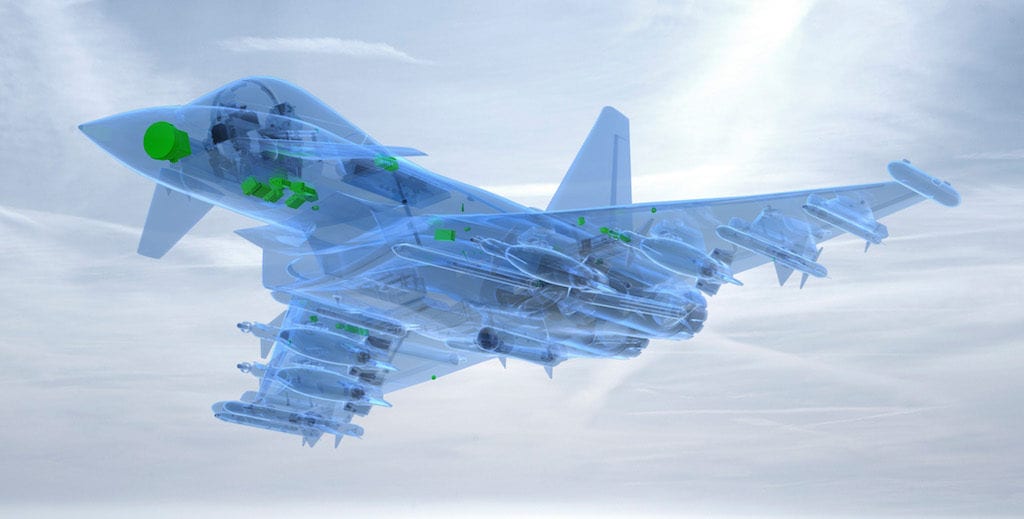
A June 17 defense budget released by Germany’s Bundestag includes $1.7 billion dedicated to upgrading the nation’s Eurofighter Typhoon fleet with a new AESA radar supplied by Hensoldt. Photo: Hensoldt
Germany’s Bundestag released a new defense budget June 17 that will see Hensoldt take the lead in developing core sensor technology for the Active Electronic Scanning Array (AESA) radar upgrade coming the German and Spanish fleet of Eurofighter Typhoons.
The need for Eurofighter’s AESA radar upgrade has been discussed for a number of years, with some nations – Kuwait, Qatar and Saudi Arabia – that operate the jet already set to upgrade the aging M-scan Captor C radar with the next-generation Captor-E AESA radar developed by Leonardo. Bundestag’s new budget includes $1.7 billion for state-funded sensor house Hensoldt to complete development, production and integration work for the AESA upgrade.
The upgrade will create the new “Mk1”radar, as a replacement for the current “Mk0.”

A computer model rendering of the future AESA upgrade coming to the German and Spanish Eurofighter fleet. Photo: Hensoldt
Airbus Defense and Space will be responsible for equipment design and support of the installation, while subcontracting the radar system upgrade to Hensoldt. This will shift the leadership of major technology upgrades for the Eurofighter, a role taken on by the British in the past, to Germany, Hensoldt CEO Thomas Muller said in a statement confirming their role in the AESA upgrade.
“With this decision, Germany is taking on a pioneering role in the field of key technology for the Eurofighter for the first time,” Muller said.
As Spain has joined Germany in the radar upgrade for its own air force, Hensoldt expects a formal process of budget release and final decisions there to come early next year. In Germany, Hensoldt will equip the Luftwaffe’s 79 Tranche 2 and 31 Tranche 3A Eurofighters with the upgraded AESA technology.
Fighter pilots operating the jet in both nations will see some much-needed modernization from the upgrade. A mechanically scanned radar’s range is constrained by the direction it is facing and how quickly its motors can turn to steer the radar beam. Although the Eurofighter’s original M-scan Captor-C radar is seen as one of the more advanced mechanically steered radars with a lightweight antenna and robust gimbals, there is still no ability to simultaneously operate in air-to-air or air-to-ground modes.

Photo: Hensoldt
In contrast, an electronically-scanned radar can quickly scan in any direction. AESA antennas also feature no moving parts, instead being controlled by an assortment of small, solid state transmit/receive (T/R) modules, in which timing differences between the signals at each module are used to form and steer the radar beam.
A representative for Hensoldt told Avionics that the core elements of the upgraded technology it will integrate into the Eurofighter upgrade include “digital multi-channel receiver technology, X-Band AESA antenna technology transmit/receive modules and a related radar operation software modification.”
“The new Mk1 radar will open up the potential for additional functionalities such as search and rescue,” the representative said.
Additionally, the upgrade will help the Eurofighter remain a viable platform as Europe continues to move forward with its largest defense project at the moment, the Future Combat Air System (FCAS), which is to feature a sixth-generation manned fighter and unmanned, “remote carrier” platforms controlled by the pilot of the manned fighter. Manned and unmanned teaming for FCAS will be managed by a new air combat cloud, that will integrate sensor data, including from the Mk1, according to Dirk Hoke, CEO of Airbus Defense and Space.
“Bundestag approved procurement of 110 Eurofighter ESCAN radars for @team_luftwaffe. Decision secures capability growth of the fleet, increases mission effectiveness and ensures robust integration of Eurofighter into FCAS environment,” Hoke tweeted on the day the new budget was released.
Now that Germany and Spain have established an upgrade path for their fleet of fighter jets, that leaves the other two core Eurofighter nations, the U.K. and Italy, as those left remaining without an announced upgrade path for their AESA sensor yet.